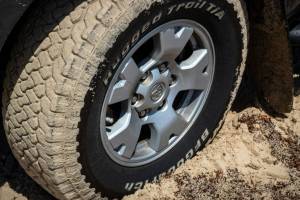
5 Tips for Tackling Sandy Roads in a 4x4 Rental
Driving on sandy roads is a common part of many overland trips in Southern Africa....
 6 May 2025
6 May 2025 
South Africa is home to an extraordinary range of wildlife experiences – and not all of them happen on land. One of the country’s most remarkable natural events takes place each winter beneath the waves of the Indian Ocean: the annual Sardine Run.
Every year, billions of sardines spawn along the Agulhas Bank and move northwards in a dramatic migration that hugs the country’s east coast. Riding the cold Benguela currents into warmer waters, the sardines travel from the Eastern Cape into KwaZulu-Natal, triggering a chain reaction of feeding frenzies from some of the ocean’s top predators.
Dolphins, sharks, gannets, seals – even whales – all descend on the coastline to gorge themselves. For a few weeks, the ocean teems with life, offering one of the most thrilling marine spectacles anywhere in the world.
But how much longer will it last?
As warming seas and ecological pressures mount, the Sardine Run faces an uncertain future. If you’re hoping to witness it for yourself, 2025 could be your year. Below, we explore what the Sardine Run is, why it’s under threat, and the best places to see it in action.
The Sardine Run is a seasonal movement of sardines (Sardinops sagax) that sees huge shoals – sometimes stretching over 7 km in length – make their way up South Africa’s east coast. Because of their sheer numbers, the shoals are often visible from the surface, and sometimes even from the beach.
In terms of biomass, the event has been compared to East Africa’s Great Wildebeest Migration. It’s one of the largest single gatherings of marine life on Earth.
The phenomenon likely involves a genetically distinct subpopulation of sardines that spawn in cooler waters and follow a narrow band of cold current northward each winter. Once trapped between the coastline and the warm waters offshore, the sardines become vulnerable – and that’s when the predators arrive.
Shoaling is a defence strategy, but against thousands of dolphins, dozens of shark species, and frenzied seabirds diving at 90 km/h, the odds aren’t good. For predators, this is a buffet. For marine tourism operators, it’s peak season.
Recent years have brought troubling signs. Since its peak in the early 2000s, the total sardine biomass has declined significantly. In 2002, researchers estimated roughly four million tonnes of sardines. Today, that figure has dropped to below a million.
Climate change is one of the primary concerns. The migration depends on cold-water upwellings along the coast – conditions that are becoming less predictable. In some years, the Sardine Run has arrived later than usual, in others, it’s been barely observable at all.
There are also broader ecological consequences. Sardines are a key food source for numerous species. A long-term shift in their availability could disrupt entire marine food webs.
Marine biologists, like Dr Stephanie Plön of Stellenbosch University, have observed worrying trends. Speaking to the BBC, she noted that dolphins off South Africa’s coast have increasingly turned to other species like mackerel in place of sardines. Similarly, seabirds such as Cape gannets and African penguins – both already under pressure – are being hit hard by the sardine shortage.
Even humpback whales, which migrate thousands of kilometres to coincide with the Sardine Run, may be making the trip for nothing.
While the future of the Sardine Run is uncertain, it’s still one of the best reasons to explore South Africa’s eastern coastline in winter. June and July are the prime months, but conditions can change quickly, so flexibility is key.
Here are three recommended locations to catch the action:
Located along the Wild Coast near Lusikisiki, Waterfall Bluff is a remote and rugged spot where freshwater tumbles straight into the sea. During the Sardine Run, the narrow coastal shelf and strong currents concentrate the shoals close to shore, offering a rare chance to observe the frenzy from high coastal cliffs.
You’ll need to hike to get there, and conditions can be unpredictable – but for photographers and adventurers, it’s one of the most dramatic viewing points.
Umkomaas is a fishing town just south of Durban, famous for its proximity to Aliwal Shoal – a renowned dive site. During the Sardine Run, fishing nets come out in full force, and the beaches buzz with activity as locals harvest the bounty.
The real highlight, though, is beneath the waves. Diving or snorkelling near Aliwal Shoal during the migration puts you in the middle of a predator-packed ecosystem – including bronze whaler sharks, dusky sharks, and bottlenose dolphins.
Just 30 minutes from Durban, Amanzimtoti is a family-friendly destination with great infrastructure and long, sandy beaches. The Sardine Run often reaches this area in late June or early July, and when it does, you might spot bait balls forming just offshore.
Keep your eyes on local social media groups and updates – locals often track the shoals in real time, and being mobile can dramatically improve your chances of seeing something spectacular. With luck, you may even spot activity right in Durban.
Because the Sardine Run is dependent on weather and ocean conditions, it’s always best to plan for flexibility. Local operators in Port St Johns, Coffee Bay, and along the KwaZulu-Natal South Coast offer guided tours, boat trips, and diving excursions.
Need transport to explore the coast at your own pace? Our team at Drive South Africa can help you find the right vehicle for the journey. Whether you’re looking for a reliable hatchback or a 4×4 for more rugged areas, we’ve got you covered.
And if you’re lucky enough to witness the Sardine Run in 2025, don’t forget to tag us in your photos and videos on Instagram at @DriveSouthAfrica!